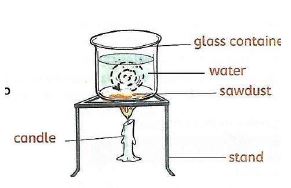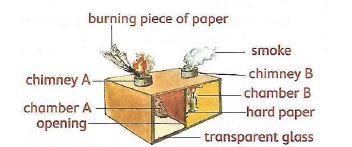
Gravity
Demonstrating Gravity
- Hold and suspend erasers in the air. Release them and tell what happens.
- Identify what causes the objects to act as they do. Name and define the cause.
- The fruits and leaves fell to the ground due to a force acting on them. The erasers dropped to the ground due to a force acting on them. This force is known as gravity.
- Gravity is defined as the force acting on objects pulling them down.
Effects of gravity on an object.
- The force that pulls down things is called the force of gravity.
- When you throw a ball into the air, gravity pulls it back down. When you release a stone suspended in the air, gravity pulls it down to the ground.
- When the books are tipped at the edge of the desk, the fall down due to gravity.
- Gravity causes fruits and leaves to fall from trees.
- Gravity is a force that pulls things down. It is also called the normal force.
Application of Gravity.
- The force of gravity enables the following in our lives:
- Gravity causes a ball you throw in the air to come down again
- It cause a glass to drop down and fall onto the floor
- It causes us to move down and slide
- It causes apple to fall down from apple tree
- It keeps us firmly on earth, otherwise we would float away into space.
- It causes a pen that rolls off your desk to fall onto the floor
- It causes water to move down a river and waterfall.
- It causes a rock to roll downhill.

Sound
Energy Producing sounds
- Sounds are produced when we the following
- Clap our hands
- Stamp our feet
- When we whistle.
- When we hot a drum
- Playing guitar
- Sound is the energy that things produce when they vibrate.
Loud and soft sounds
- Volume is the amount of sound something produces.
- It is the measure of the loudness of sound. Loud sounds are produced by big vibrations, while low sounds are produced by small vibrations.
- The energy of a sound determines its loudness. The greater the energy the greater the sound.
- Whispering makes a soft sound while shouting to a friend across a playground makes a loud sound.
- Fire alarms and car’s horn are examples of loud sounds, while whispering to a friend and the sound of blowing wind are examples of soft sounds.
Identifying areas with loud sounds
- Areas that produce loud sound in the environment include:
- Industries
- Music shops
- Markets
- Stadia (plural for stadium)
Sound pollution
- Sound pollution is defined as sounds or noises that are loud, annoying and harmful to the ears.
Effects of sound pollution
- The effect of sound pollution on human health and behaviour include the following:
- Loss of hearing - the immediate effect of noise pollution to a person, over a period of time is reduced hearing ability. Over a time a person may completely lose his or her hearing.
- Poor concentration - loud and continuous noise makes a person lose concentration on any activity that they are carrying out.
- Irritability - loud and continuous noise at home and at school may result in irritability which lead to aggressive behaviour.
- Sleep disturbances - loud noise disturbs your sleep and keeps you awake.
- Interferences with communication - loud noise makes people unable to communicate freely. You may find it difficult to understand or even hear what someone else is saying.
Protecting self from loud sound
- Turning down devices producing loud sound
- Using hearing protection devices when in a place with loud sound.
- Avoid areas with loud sound.
- Staying in houses with soundproof walls.

Heat Transfer
Demonstrating Transfer of heat in liquids
- Materials
- Sawdust
- A glass container
- A stand
- Water
- A matchbox
- A source of heat (a candle)
Procedure
- Fill in the glass container with water
- Place a small amount of sawdust in the water
- Allow the sawdust to settle at the bottom of the container
- Place the glass container on the stand
- Heat the container using candle as the source of heat
- Observe what happens.
- As the water continues to heat, a steady rise of sawdust is observed. This is because the water at the bottom of the glass container gets hotter, expands and rises.
- The cold water at the top then moves downwards and takes the place of the risen hot water.
- The cycle repeats itself. The sawdust particles show a movement in the water called convection currents.
- Therefore, heat is transferred in liquids through convection.
(convection currents in liquids)
(heating water via convection)
Demonstrating transfer of heat in gases
- Materials
- A small carton box with a top
- Hard paper or piece of carton
- A piece of paper
- A short candle
- A matchbox
Procedure
- Make a chimney on each end of the top of the box
- Divide the box with hard paper or a piece of carton to make two chambers A and B. place the transparent glass on the side of the box for viewing.
- Light up a candle. Put the lit candle below the chimney B on the box. Close the box.
- Place a burning piece of paper over chimney A as shown in figure 6
- Observe chimney B and tell what you see.
- Record your observations.
- The burning paper produces smoke that moves from chamber A to Chamber B through the opening.
- The candle in chamber b heats the smoke coming from chamber A, which becomes lighter and rises.
- As the smoke rises up it moves up through chimney B. Cooler air enters Chamber A through chimney A, creating a circular motion known as convection currents.
- These currents can be viewed through the transparent glass.
- The transfer of heat in gases is known as Convection
(convection in gases)
Application of convection in everyday life
- Convection of heat is used in everyday life by many ways. These ways include:
- Ventilating buildings
- Inflation of hot air balloons
- Heating of food in a microwave
- Formation of land and sea breezes
- Boiling of water in a sufuria or kettle
- Vehicle engines
Transfer of heat by radiation
- When you stand in the sunlight, you can feel the warmth of the sun. The heat energy from the sun is transferred to your skin through radiation.
- When you sit beside a fire, you feel warm. The warmth of the heat from the fire is transferred from the fire to you through radiation.
Application of radiation in everyday life
- Radiation is used in everyday life in many ways. These ways include:
- Warming ourselves using electric heaters
- Using solar heaters in the house
- Drying clothes and grains
- Using greenhouses to aid growth of plants
Join our whatsapp group for latest updates
Tap Here to Download for 30/-
Get on WhatsApp for 30/-
Download Force and Energy - Grade 5 Science and Technology Revision Notes.
Tap Here to Download for 30/-
Get on WhatsApp for 30/-
Why download?
- ✔ To read offline at any time.
- ✔ To Print at your convenience
- ✔ Share Easily with Friends / Students




